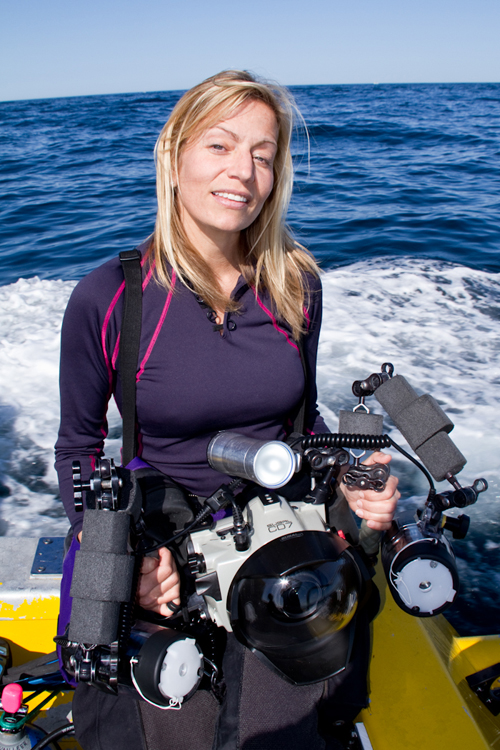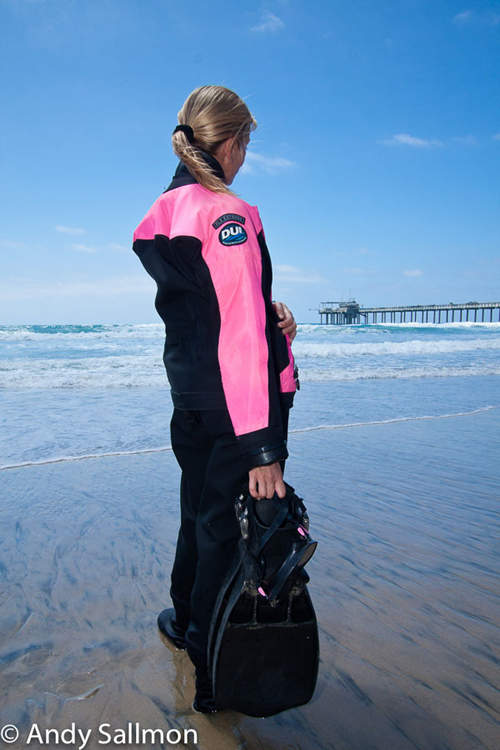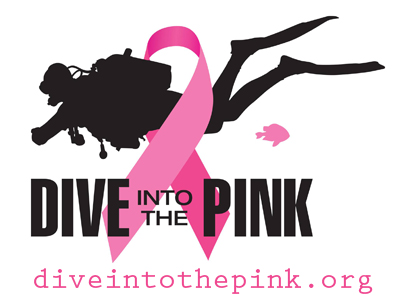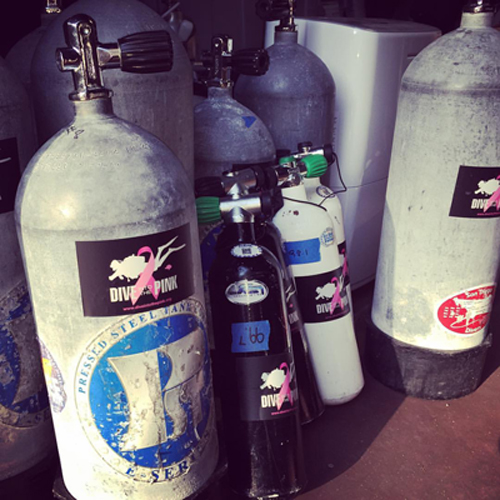
Dive into the Pink

In 2003, I was many things – 33 years old, a postdoctoral fellow at a Boston-area university, a veterinary researcher, a scuba diver, a workout fanatic. What I wasn’t was someone with a lot of free time.
So on the October day that I placed my hand on my left breast and found a distinct mass, I was more annoyed than frightened. Still, instinct told me to get things checked out, so I made an appointment at the student health care center. The consultation only heightened my irritation – my doctor looked me in the eye and told me that he was not convinced I had a mass at all – and that I was too young to have breast cancer anyways.
The rest of the exchange went a bit like this: I informed the physician that I was 100% sure there was something in my breast, that I didn’t have time for this nonsense, and that I would be referred for a closer evaluation or I would become the bane of his practice.
It was a good thing he took me at my word, because in the end, my busy schedule didn't matter, nor did my age or anyone's assumption that the mass was benign. The fact was, I had high-grade invasive breast cancer, and my young age meant that there was no time to analyze the situation.
Fortunately, I was near the end of my fellowship and had recently begun interviewing for positions at several local companies. I hastily accepted a job with great health care coverage and seriously pondered life beyond the studying that had defined me for so long.
How did I break the news to my family? Should I pursue genetic testing? And did I want to have children (because if I did, I needed to see a fertility specialist immediately since treatment could wipe out my ovaries)? What if I couldn’t beat this monster?
There was an abrupt shift in my personal relationships – several of my closest friends, unable to handle the news of my diagnosis, essentially disappeared off the map (years later at a dinner party, a woman I’d been dear friends with who’d abruptly vanished during my year of treatment asked me in rapt amazement, “Wait, you had chemo? Your HAIR fell out?”).
Perhaps one of the most isolating events was my orientation visit to the oncology clinic: My mom had flown in to attend with me, and everyone immediately assumed that she was the patient – because I was the youngest customer in the room by about 20 years. Blessedly, I discovered the Young Survival Coalition, an organization dedicated to supporting women under 40 with breast cancer; within 2 weeks of my first email to them, I had a local network of women my age who were there to give advice, hold my hand, and act as cheerleaders (only far more spirited than you’d find on any football field). Trust me, when you’re feeling terrified, few things are more uplifting than having a friend flash you with her fabulously reconstructed chest and quip, “You, too, will soon fill out any bikini tops you choose!”
4 weeks later, I sat – still stunned and scared, but resolute - in the infusion ward at Mass General, aware that my life was about to change drastically and forever. As a nurse approached me with the chemotherapy drugs that would kill the breast cancer cells (along, unfortunately, with the cells lining my hair follicles and my intestines), I made a hasty promise to myself: I am not going to let this thing ruin my life. I will keep working, I will keep diving, I will keep going to the gym, I will support the other people I meet who are fighting this stupid disease, and - most importantly of all - I will never, ever have a bad hair day again.
 I kept most of those promises, although alas, I am still plagued by bad hair days. I worked and went to the gym all the way through my treatment, more than a little pleased to discover that there are many people in the world who harbor a crush on Lieutenant Ilia (a gorgeous bald female navigator in the film Star Trek: The Motion Picture).
I kept most of those promises, although alas, I am still plagued by bad hair days. I worked and went to the gym all the way through my treatment, more than a little pleased to discover that there are many people in the world who harbor a crush on Lieutenant Ilia (a gorgeous bald female navigator in the film Star Trek: The Motion Picture).
I became active with the Young Survival Coalition, participating in support meetings, Q&A panels, and fundraising events. And once I was fully recovered, I bought myself a drysuit, which greatly expanded my diving options. I was a SURVIVOR (note the all-caps) and I thought about beating cancer every day.
Five years later, I was still doing well, and my doctors were very positive about my long term prognosis. I took a job in California so I could dive comfortably year-round, and I bought my first underwater camera. But as things sometimes tend to go, just as my world started to seem normal and predictable again, life served up a horribly unfair twist.
One of my best friends from the Young Survival Coalition (the flasher in my aforementioned cheerleader scenario) announced that her doctors had discovered extensive metastatic disease – her cancer, which we’d all thought was long gone, had come back, and there was not going to be a cure. She passed away shortly thereafter, long before her 40th birthday.
That knocked me for a loop. After that, I decided it was time to go from being a SURVIVOR to being a survivor for a bit, and I busied myself with non-cancer activities. Diving hard, working hard, improving my photography – my desired focus was on anything but illness, and I stopped participating in organized support and fundraising efforts.
Even then, I kept getting pulled back in small ways. Remembering how isolated I’d felt after my diagnosis and how much others had helped me, I made time to answer questions from people who were facing treatment, and I remained in loose contact with the rest of my original support circle. And as my cold water diving became more intense, I noticed that I would sometimes experience skin bends-like symptoms adjacent to some of my surgical sites, a situation that resulted in consultations with several specialists and the adoption of very conservative diving profiles.
In 2010, I happened across the Duke Medical Center booth at the DEMA (Dive Equipment & Marketing Association) Show, and on a whim, I walked over and stuck up a discussion with Dr. Dawn Kernagis. We discussed my diving history, both before and after I had been diagnosed with breast cancer, and I asked if any research had been or was being performed to look specifically at women in my situation.
Although she didn’t know of any, she took my contact information. We shook hands and parted ways, but she emailed me shortly thereafter. She wanted to do some further investigations into breast cancer survivors who were active scuba divers.
That brief discussion resulted in Dawn’s and Duke Medical Center’s multi-phase study, Project Pink Tank, intended to become a comprehensive investigation of diver health among breast cancer survivors.
 The day this project formally went “live” in the form of an online survey, my inner SURVIVOR came roaring back to life. I began acquiring pieces of pink dive gear – not because I am overly fond of the color, mind you, but because it is a recognizable symbol of the disease I conquered.
The day this project formally went “live” in the form of an online survey, my inner SURVIVOR came roaring back to life. I began acquiring pieces of pink dive gear – not because I am overly fond of the color, mind you, but because it is a recognizable symbol of the disease I conquered.
It never seemed like I was doing enough, however. Certainly, there are many breast cancer fundraising events that offer a chance for volunteerism and participation every October (officially designated as Breast Cancer Awareness month), but as California divers know, October is typically a prime diving month. It is a tall order to give up those stellar dive days for any cause, no matter how worthy.
Then last September, I was at a party chatting with a friend who works as a local divemaster and dive boat captain. I told her that my “cancerversary” – the anniversary of the October day when I first found out I had cancer -was approaching, and I bemoaned the fact that my diving addiction prevents me from regularly participating in the numerous events that overtake the weekends every October.
As we laughed, an idea took root. I might not be thrilled to sacrifice a Saturday in October to run a 5K, but what if that incredible October dive day could BE a breast cancer awareness event on its own? I turned to my friend and asked, “Hey - do you have any open charter dates next month?”
I worked closely with Waterhorse Charters’ Humboldt dive boat to choose a date and dive sites, and then I created an invitation-only “pilot” event, working to accumulate shirt donations and a few small “swag bag” items. Then I pondered what would make the dive day special and especially fun for those who participated, and I came up with a rule: Pink. That is, everyone who showed up was required to be sporting a piece of bright pink dive gear.
If a diver showed up without pink gear, an item would be selected for them from my extensive collection (woe betide the small-statured man who could fit into my bright pink drysuit). Deciding where to donate the proceeds was a cinch – all money would be split between the Young Survival Coalition and Project Pink Tank, both endeavors that had been of paramount significance to me during my journey as a patient and survivor.
The event was a massive success, with both men and women signing up as soon as the tickets were offered. I had a sellout boat within a week, and several divers contacted me privately to tell me how cancer had touched their family or the family of a friend. On the day of the charter, I held back tears as I watched members of my local dive community – men and women alike – trudge aboard with full complements of pink gear and accessories. Local dive instructor Tony So had restrung his backplate with pink webbing and replaced his black regulator hose with a bright pink one, and diver Mike Hallack proudly sported a pink mask strap (replete with pink ribbon).
 Divers Dana Rodda and Jami Leslie Feldman wore bright pink gloves, and Nayan Savla (using double tanks) and Bill Reals (on a rebreather) happily donned bright pink tutus on the boat. We snapped photos and posted to social media as the day progressed, and the online response was phenomenal, with lots of positive attention from divers all over the world and several unsolicited donations (these were individually re-routed to the Young Survival Coalition and Project Pink Tank).
Divers Dana Rodda and Jami Leslie Feldman wore bright pink gloves, and Nayan Savla (using double tanks) and Bill Reals (on a rebreather) happily donned bright pink tutus on the boat. We snapped photos and posted to social media as the day progressed, and the online response was phenomenal, with lots of positive attention from divers all over the world and several unsolicited donations (these were individually re-routed to the Young Survival Coalition and Project Pink Tank).
Men and women from as far away as the Bahamas contacted me, offering support if I should ever want to run an event at a remote site. In other words, the event was a smash hit – and in its wake, that left a lot for me to think about. Could I create something like this annually, harnessing the enthusiasm of that first event and pulling in involvement from divers farther afield than Southern California? I thought it might be possible.
Between my primary job as a scientist and my “free time” job as an underwater photographer and writer for various editorial outlets, I have even less time on my hands now than I did when I first discovered my breast tumor. However, that inconvenience – shared by so many of us - is the key to what I hope to accomplish. I don’t have time to put together an elegant gala or a fancy auction, but I am easily able to scrounge up the time to organize a dive charter, and I suspect that others would volunteer the time and effort to do the same.
In January, I formally founded Dive into the Pink as a nonprofit organization, and we have applied for 501c3 status. Our mission will be to run dive charters with all proceeds being redistributed to benefit selected breast cancer research and patient/survivor support endeavors - by doing so, we give divers a way to give to “donate” by doing nothing more than what they’d already be doing on a free afternoon in October: diving. For 2016, I have teamed up with fellow breast cancer survivor and avid diver Janet Pinterits to create two events, scheduled for San Diego (on the Humboldt dive boat) and Los Angeles/San Pedro (on Assante Charters). Our 2017 goal is to add a third charter, and from there, who knows? We need to build slowly to ensure that the events are well thought-out and that troubleshooting and planning are as easy as possible, but this could ultimately become a widespread fundraising effort, utilizing remote partners to organize similar charters across the country.
Although Dive into the Pink is still in its infancy, the SURVIVOR born inside me in October 2003 is now definitively present and stronger than ever. As a friend wrote to me on social media after the 2015 charter, “You know you’re fully recovered from cancer when you can start to give back.” I think she might be right.
For more information on Dive into the Pink or our 2016 events, go to www.diveintothepink.org or www.diveintothepink.com, or visit our Facebook page at www.facebook.com/diveintothepink
Written by Allison Vitsky Sallmon, San Diego. First published in California Diving News, April 2016.
Photo Credit Andy Sallmon.
